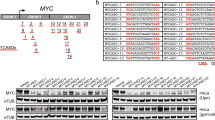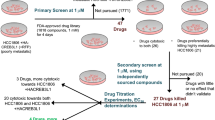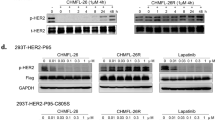Abstract
Poor response to chemotherapy in patients with breast cancer is often associated with overexpression of HER-2/ neu. Interference with HER-2 mRNA translation by means of antisense oligonucleotides might improve the efficacy of chemotherapy. To test this hypothesis, eight breast cancer cell lines and a normal human fibroblast cell line were examined for their level of HER-2 expression, their sensitivity to phosphorothioate antisense oligonucleotides (AS HER-2 ODN), and to various chemotherapeutic agents, and the combination of the two. No correlation was found between the intrinsic HER-2 level and either the sensitivity to a particular chemotherapeutic agent alone, or the amount of growth inhibition observed with a specific AS HER-2 ODN concentration. Although sequence specificity and extent of AS HER-2 ODN inhibition of HER-2 synthesis were somewhat higher in the HER-2 overexpressing MDA-MB-453 and SK-BR-3 cells, we found that antisense treatment significantly sensitized all of the breast cancer cells, even MDA-MB-231 and MDA-MB-435 cells, with approximately basal levels of HER-2, to various chemotherapeutic agents. In addition, the combination of AS HER-2 ODN and taxol was shown to synergistically induce apoptosis in MDA-MB-435. These results demonstrate that overexpression of HER-2 would not be a prerequisite for the effective use of AS HER-2 ODN as a combination treatment modality for breast cancer and suggest that the use of AS HER-2 ODN, as part of a combination treatment modality, need not be limited to breast tumors that display elevated levels of HER-2. Cancer Gene Therapy (2001) 8, 728–739
This is a preview of subscription content, access via your institution
Access options
Subscribe to this journal
Receive 12 print issues and online access
$259.00 per year
only $21.58 per issue
Buy this article
- Purchase on Springer Link
- Instant access to full article PDF
Prices may be subject to local taxes which are calculated during checkout
Similar content being viewed by others
References
Dougall WC, Qian X, Peterson NC, Miller MJ, Samanta A, Greene MI . The neu -oncogene: signal transduction pathways, transformation mechanisms and evolving therapies Oncogene 1994 9: 2109–2123
Tzahar E, Yarden Y . The ErbB-2/HER2 oncogenic receptor of adenocarcinomas: from orphanhood to multiple stromal ligands Biochim Biophys Acta 1998 1377: M25–M37
Kltapper LN, Glathe S, Vaisman N, et al . The ErbB-2/HER2 oncoprotein of human carcinomas may function solely as a shared coreceptor for multiple stroma-derived growth factors Proc Natl Acad Sci USA 1999 96: 4995–5000
Klapper LN, Kirschbaum MH, Sela M, Yarden Y . Biochemical and clinical implications of the ErbB/HER signaling network of growth factor receptors Adv Cancer Res 2000 77: 25–79
King CR, Kraus MH, Aaronson SA . Amplification of a novel v- erbB -related gene in a human mammary carcinoma Science 1985 229: 974–976
King CR, Swain SM, Porter L, Steinberg SM, Lippman ME, Gelmann EP . Heterogeneous expression of erbB-2 messenger RNA in human breast cancer Cancer Res 1989 49: 4185–4191
Slamon DJ, Clark GM, Wong SG, Levin WJ, Ullrich A, McGuire WL . Human breast cancer: correlation of relapse and survival with amplification of the HER-2/ neu oncogene Science 1987 235: 177–182
Slamon DJ, Godolphin W, Jones LA, et al . Studies of the HER-2/ neu proto-oncogene in human breast and ovarian cancer Science 1989 244: 707–712
Kraus MH, Popescu NC, Amsbaugh SC, King CR . Overexpression of the EGF receptor-related proto-oncogene erbB-2 in human mammary tumor cell lines by different molecular mechanisms EMBO J 1987 6: 605–610
Berger MS, Locher GW, Saurer S, et al . Correlation of c- erbB -2 gene amplification and protein expression in human breast carcinoma with nodal status and nuclear grading Cancer Res 1988 48: 1238–1243
Tal M, Wetzler M, Josefberg Z, et al . Sporadic amplification of the HER2/ neu protooncogene in adenocarcinomas of various tissues Cancer Res 1988 48: 1517–1520
Stancovski I, Sela M, Yarden Y . Molecular and clinical aspects of the Neu/ErbB-2 receptor tyrosine kinase Cancer Treat and Research 1994 71: 161–191
Yu D, Liu B, Tan M, Li J, Wang SS, Hung MC . Overexpression of c- erbB -2/ neu in breast cancer cells confers increased resistance to Taxol via mdr-1-independent mechanisms Oncogene 1996 13: 1359–1365
Ross JS, Fletcher JA . The HER-2/ neu oncogene: prognostic factor, predictive factor and target for therapy Semin Cancer Biol 1999 9: 125–138
Pietras RJ, Pegram MD, Finn RS, Maneval DA, Slamon DJ . Remission of human breast cancer xenografts on therapy with humanized monoclonal antibody to HER-2 receptor and DNA-reactive drugs Oncogene 1998 17: 2235–2249
Pegram M, Hsu S, Lewis G, et al . Inhibitory effects of combinations of HER-2/ neu antibody and chemotherapeutic agents used for treatment of human breast cancers Oncogene 1999 18: 2241–2251
Cook PD . Antisense Research and Applications Boca Raton: CRC Press 1993.
Pirollo KF, Hao Z, Rait A, Ho CW, Chang EH . Evidence supporting a signal transduction pathway leading to the radiation-resistant phenotype in human tumor cells Biochem Biophys Res Commun 1997 230: 196–201
Rait A, Krygier JE, Pirollo KF, Chang EH . Sensitization of Breast Cancer Cells to Taxol by Antisense HER-2 Oligonucleotides Antisense Nucleic Acid Drug Dev 1999 9: 403–408
Szollosi J, Balazs M, Feuerstein BG, Benz CC, Waldman FM . ErbB-2 (HER2/ neu ) gene copy number, p185HER-2 overexpression, and intratumor heterogeneity in human breast cancer Cancer Res 1995 55: 5400–5407
Xie Y, Hung MC . p66Shc isoform down-regulated and not required for HER-2/ neu signaling pathway in human breast cancer cell lines with HER-2/ neu overexpression Biochem Biophys Res Commun 1996 221: 140–145
Bennett CF, Chiang MY, Chan H, Shoemaker JE, Mirabelli CK . Cationic lipids enhance cellular uptake and activity of phosphorothioate antisense oligonucleotides Mol Pharmacol 1992 41: 1023–1033
Scudiero DA, Shoemaker RH, Paull KD, et al . Evaluation of a soluble tetrazolium/formazan assay for cell growth and drug sensitivity in culture using human and other tumor cell lines Cancer Res 1988 48: 4827–4833
Colomer R, Lupu R, Bacus SS, Gelmann EP . erbB-2 antisense oligonucleotides inhibit the proliferation of breast carcinoma cells with erbB-2 oncogene amplification Br J Cancer 1994 70: 819–825
Liu X, Pogo BG . Inhibition of erbB-2 –positive breast cancer cell growth by erbB-2 antisense oligonucleotides Antisense Nucleic Acid Drug Dev 1996 6: 9–16
Ru K, Taub ML, Wang JH . Specific inhibition of breast cancer cells by antisense poly-DNP-oligoribonucleotides and targeted apoptosis Oncol Res 1998 10: 389–397
Guvakova MA, Yakubov LA, Vlodavsky I, Tonkinson JL, Stein CA . Phosphorothioate oligodeoxynucleotides bind to basic fibroblast growth factor, inhibit its binding to cell surface receptors, and remove it from low affinity binding sites on extracellular matrix J Biol Chem 1995 270: 2620–2627
Cailleau R, Young R, Olive M, Reeves WJ Jr . Breast tumor cell lines from pleural effusions J Natl Cancer Inst 1974 53: 661–674
Koopman G, Reutelingsperger CP, Kuijten GA, Keehnen RM, Pals ST, van Oers MH . Annexin V for flow cytometric detection of phosphatidylserine expression on B cells undergoing apoptosis Blood 1994 84: 1415–1420
Nagata S . Apoptosis by death factor Cell 1997 88: 355–365
Reed JC . Bcl-2 family proteins Oncogene 1998 17: 3225–3236
Bhalla K, Ibrado AM, Tourkina E, Tang C, Mahoney ME, Huang Y . Taxol induces internucleosomal DNA fragmentation associated with programmed cell death in human myeloid leukemia cells Leukemia 1993 7: 563–568
Vaughn JP, Iglehart JD, Demirdji S, et al . Antisense DNA downregulation of the ERBB2 oncogene measured by a flow cytometric assay Proc Natl Acad Sci USA 1995 92: 8338–8342
Vaughn JP, Stekler J, Demirdji S, et al . Inhibition of the erbB-2 tyrosine kinase receptor in breast cancer cells by phosphoromonothioate and phosphorodithioate antisense oligonucleotides Nucleic Acids Res 1996 24: 4558–4564
Bertram J, Killian M, Brysch W, Schlingensiepen KH, Kneba M . Reduction of erbB-2 gene product in mamma carcinoma cell lines by erbB-2 mRNA-specific and tyrosine kinase consensus phosphorothioate antisense oligonucleotides Biochem Biophys Res Commun 1994 200: 661–667
Allal C, Sixou S, Kravtzoff R, Soulet N, Soula G, Favre G . SupraMolecular BioVectors (SMBV) improve antisense inhibition of erbB-2 expression Br J Cancer 1998 77: 1448–1453
Roh H, Pippin J, Boswell C, Drebin JA . Antisense oligonucleotides specific for the HER2/ neu oncogene inhibit the growth of human breast carcinoma cells that overexpress HER2/ neu J Surg Res 1998 77: 85–90
Pegram MD, Finn RS, Arzoo K, Beryt M, Pietras RJ, Slamon DJ . The effect of HER-2/ neu overexpression on chemotherapeutic drug sensitivity in human breast and ovarian cancer cells Oncogene 1997 15: 537–547
Kallioniemi OP, Kallioniemi A, Kurisu W, et al . ERBB2 amplification in breast cancer analyzed by fluorescence in situ hybridization Proc Natl Acad Sci USA 1992 89: 5321–5325
Brunner D, Oellers N, Szabad J, Biggs WH, III, Zipursky SL, Hafen E . A gain-of-function mutation in Drosophila MAP kinase activates multiple receptor tyrosine kinase signaling pathways Cell 1994 76: 875–888
Hsu JC, Perrimon N . A temperature-sensitive MEK mutation demonstrates the conservation of the signaling pathways activated by receptor tyrosine kinases Genes Dev 1994 8: 2176–2187
DeFazio A, Chiew YE, Sini RL, Janes PW, Sutherland RL . Expression of c- erbB receptors, heregulin and oestrogen receptor in human breast cell lines Int J Cancer 2000 87: 487–498
Acknowledgements
We thank Charles Kocher and Leanne Sleer for their assistance in the preparation of this manuscript, Dr. Karen Creswell for her help with the flow cytometry studies and the support of the Flow Cytometry/Cell Sorting and Tissue Culture Shared Resources of the Lombardi Cancer Center. This work was supported in part by National Foundation for Cancer Research Grant HU0001 (E.H.C.).
Author information
Authors and Affiliations
Corresponding author
Rights and permissions
About this article
Cite this article
Rait, A., Pirollo, K., Rait, V. et al. Inhibitory effects of the combination of HER-2 antisense oligonucleotide and chemotherapeutic agents used for the treatment of human breast cancer. Cancer Gene Ther 8, 728–739 (2001). https://doi.org/10.1038/sj.cgt.7700359
Received:
Published:
Issue Date:
DOI: https://doi.org/10.1038/sj.cgt.7700359
Keywords
This article is cited by
-
A novel quantitative immunohistochemistry method for precise protein measurements directly in formalin-fixed, paraffin-embedded specimens: analytical performance measuring HER2
Modern Pathology (2017)
-
Differential sensitivities of trastuzumab (Herceptin®)-resistant human breast cancer cells to phosphoinositide-3 kinase (PI-3K) and epidermal growth factor receptor (EGFR) kinase inhibitors
Breast Cancer Research and Treatment (2005)
-
Tumor-targeting, Systemically Delivered Antisense HER-2 Chemosensitizes Human Breast Cancer Xenografts Irrespective of HER-2 Levels
Molecular Medicine (2002)



